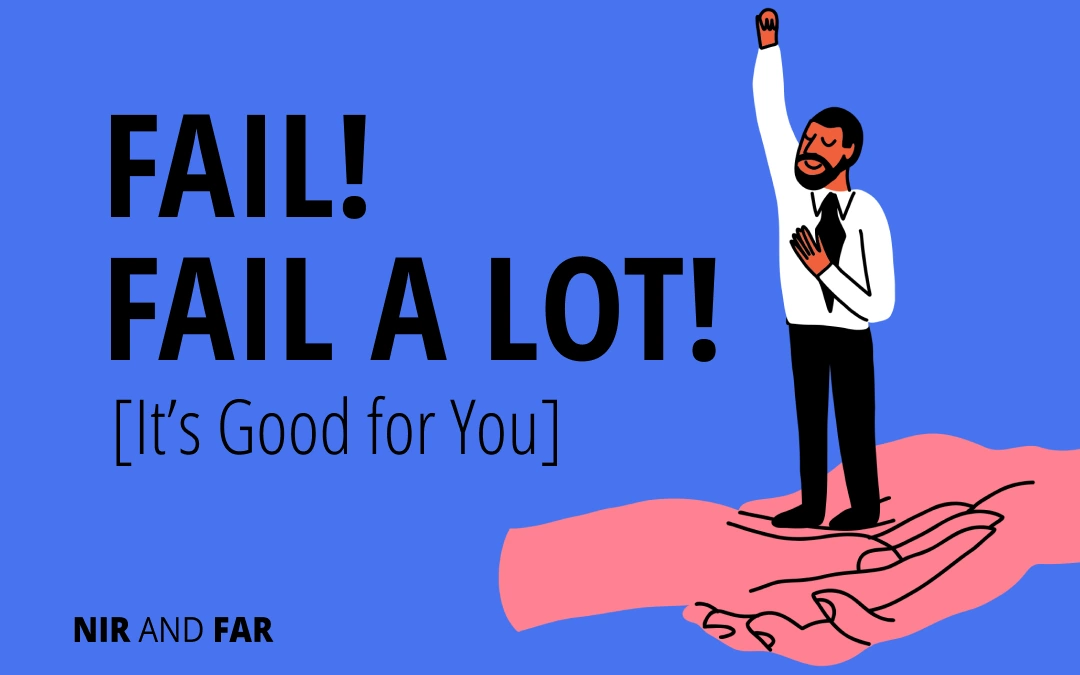“There is no innovation and creativity without failure. Period.” —Brené Brown
Failure is baked into the human experience. So why are we so terrible at dealing with it?
Fear of judgment and the stigma that our failures reflect poorly on us discourage us from trying new things. Negative self-talk and rumination convince us that our failures mean we’re incapable and undeserving.
But failure is typical in all professions.
Organizations across industries see an average win rate of 43 percent for the requests for proposals (RFPs) they send to solicit bids for potential business; that means 57 percent of their RFPs fail.
New surgeons have a 30-day mortality rate of 6.2 percent—meaning 6.2 percent of patients they operated on died within 30 days after surgery—and experienced surgeons have a 4.5 percent rate.
One in four businesses fail within the first year. Within 10 years, 70 percent of companies fail.
Amazon was once predicted to fail. Imagine if Jeff Bezos allowed that to deter him.
Why make ourselves feel miserable for failing when it’s a factor of progress and a prerequisite for success?
If we want to succeed, we must become resilient to failure. Thankfully, resilience is a skill that can be learned.
Understand the Failure Response
To overcome failure, it’s helpful to recognize that what we feel in the aftermath is not particular to each of us as individuals. Every person knows what failure feels like. Maybe that will allow you to show yourself a little more compassion when you experience it yourself.
Humans take failure hard.
For starters, we have a physiological response to failure: It triggers the fight-or-flight response in the body.
Imagine you receive an email from a client, coworker, or boss expressing dissatisfaction with a task you performed. The subject reads “Feedback,” and the first few words say, “This wasn’t what I was expecting…” or “I’m disappointed to see…” Your heart rate leaps, and you break out in a sweat. Instead of thinking through the email and dealing with your emotions, you tell yourself, “I can’t deal with this right now,” click over to check sports scores or watch a YouTube video to escape your distress by wallowing in distraction.
Reading the email triggers your brain’s neural processes associated with failure. These processes include emotional regulation, interoceptive awareness(awareness of sensory information), error detection, and social information processing. This activity stimulates the production of hormones and neurotransmitters, such as the stress hormone cortisol, and, ultimately, the fight-or-flight response.
Like many other human characteristics, this response helped our ancestors survive thousands of years ago when failure was closely linked to death. Today, our failures are rarely fatal—so the response is far out of proportion to what we experience. Our bodies make us feel that receiving an email with criticism is life-threatening.
Our response extends to our behavior and emotions as well. A rush of negative emotions, such as shame, guilt, and anger, is typical. We feel shame because we fear failure affects our relational value, or “the extent to which one feels valued by important others.” Failure is a hit to our self-esteem, and we may feel cognitive dissonance, which is discomfort that arises when our behavior clashes with our values. If we perceive ourselves to be a good worker or competent or reliable, then receiving feedback or doing something to the contrary sends us into a tailspin.
The failure response is drastic, and we can’t change it. But we can manage it.
The Building Blocks of Resilience
Self-Compassion
Your inner critic is one of the limiting beliefs holding you back. That voice loves to come out after any failure to criticize you, tell you you’ll never be good enough, and make you feel worthless for the slightest offense. If you feel useless, you can’t bounce back from failure.
So, to become resilient, you first have to become self-compassionate.
Brené Brown, a research professor at the University of Houston, has spent decades studying courage, vulnerability, shame, and empathy. In 2010, she gave a TED Talk about vulnerability with 22 million views on YouTube, and two years later, she gave one about shame with more than 19 million views.
Brown encourages people to embrace failure because it’s part of the path to progress. Failing means you’re trying. She also says empathy is the best antidote to shame, which is “an epidemic in our culture.”
A great way to foster self-compassion is by sharing failures with others to normalize the experience and reduce feelings of isolation.
Brown’s second TED Talk was, in itself, a practice in failure sharing (she described the shame and vulnerability she felt after giving her first TED talk). “If you put shame in a Petri dish, it needs three things to grow exponentially: secrecy, silence, and judgment,” she said. “If you put the same amount in a Petri dish and douse it with empathy, it can’t survive. The two most powerful words when we’re in struggle: me too.”
Positivity
Adopting a positive outlook is critical to resilience. Richard Wiseman, a psychologist who spent a decade studying what makes lucky people tick, determined that their most important quality is resilience: They use a positive attitude to turn bad luck into promising opportunities.
The science behind “manifestation” supports this idea, showing that good things come to those with a positive outlook. First, people who think they can do something attempt it; simply trying increases their chances of success.
When we use positivity to see failure as a stepping stone rather than a stumbling block, we learn to approach failure with courage and optimism.
To build a positive outlook in the face of failure, try lucky people’s tactic: Reframe your failure as an opportunity. You can also repeat a science-backed affirmation that resonates with you and inspires positive emotions. For example, we’ve all heard that “practice makes perfect.” In reality, “practice makes progress.”
Design and Practice an “I Failed” Process
If you set yourself to succeed, you set yourself to fail first. So, if you plan to get out of your comfort zone and try new things, it’s best not to make yourself feel like crap every time they don’t work.
For those who plan to succeed, developing a procedure for what to do when you fail is smart. Develop it and practice it for failures, small to large. Each time you use it, it will reinforce your resilience.
Here’s what to do when you experience failure.
Step 1: Pause.
Take a moment to reflect and process your emotions and thoughts. Don’t catastrophize. Focus on your emotional response to failure rather than trying to rationalize it.
Part of my four-step process to master internal triggers, or negative feelings that drive us to distraction, is to explore those feelings with curiosity rather than contempt. This approach allows you to shift your mindset away from blame and shame.
Free Habit Tracker
Design your ideal day and build your best life.
Your email address is safe. I don't do the spam thing. Unsubscribe anytime. Privacy Policy.
Step 2: Gather more information on the failure itself.
Seek feedback from others, objective metrics, or evidence from similar experiences if this type of failure appears to be a pattern.
Collecting more information helps us to beat confirmation bias, or the human tendency to seek, interpret, and remember information that confirms preexisting beliefs—e.g., a belief that you suck and aren’t good at your job. With more intel, we can consider explanations and perspectives other than the ones that fit our assumptions.
Take that email of negative feedback you received from your client, coworker, or boss, who said that the project you completed needed more work. In examining the situation, you might note that the project was more complex than most. On top of that, your client’s or boss’s request hadn’t been clear, so you had been operating under fuzzy direction. And, if you were being honest, the project was due the day after you had an argument with your partner that you couldn’t stop thinking about.
These pieces of information give context as to what went wrong. And none of them amount to “you suck.”
Step 3: Respond calmly.
Once you’ve had time to react privately and collect more information, you’ll likely feel ready to respond calmly to the failure. Identifying the best action is easier when you’re not reeling from a chaotic failure response.
You can’t be impervious to failure. But you can be an expert at dealing with it. Learning not to be derailed by failures is incredibly empowering. So, go fail! And practice responding well.
Related Articles
- Schedule Maker: a Google Sheet to Plan Your Week
- Habit Tracker Template in Google Sheets
- The Ultimate Core Values List: Your Guide to Personal Growth
- Timeboxing: Why It Works and How to Get Started in 2024
- An Illustrated Guide to the 4 Types of Liars
- Hyperbolic Discounting: Why You Make Terrible Life Choices
- Happiness Hack: This One Ritual Made Me Much Happier

